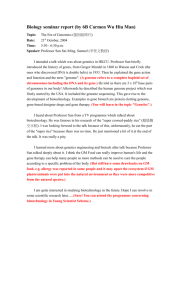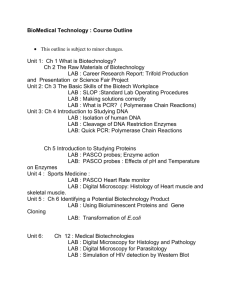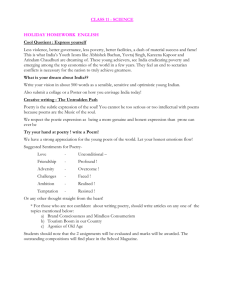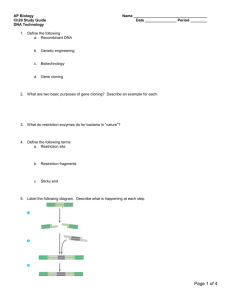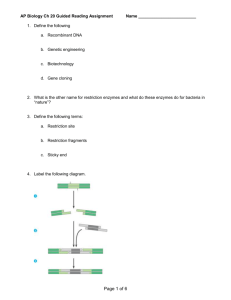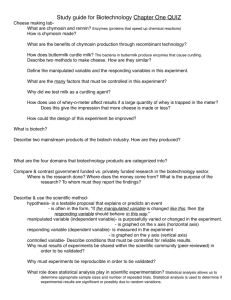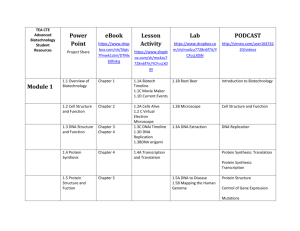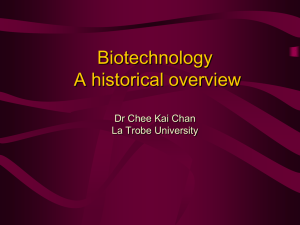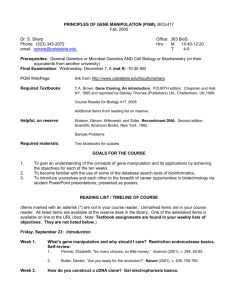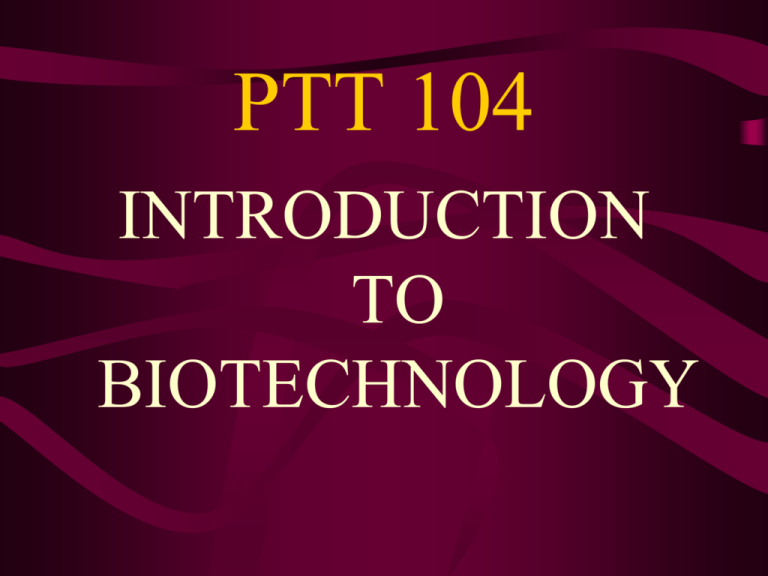
PTT 104
INTRODUCTION
TO
BIOTECHNOLOGY
Course Outcomes (C0):
• Ability to explain foundations of modern biotechnology.
• Ability to demonstrate important recent advances in
methods and applications of biotechnology with regards to
microorganisms and plants.
• Ability to differentiate scopes and importance of various
biotechnological streams.
• Ability to demonstrate understanding on ethical
implications of biotechnology.
Learning approach:
• Lectures : 28 hours (100 %)
Evaluation
•
•
•
•
•
•
•
•
•
•
Peperiksaan/ Examination: 60%
Mid-term Examination 1
Mid-term Examination 2
Final Examination
= 10%
= 10%
= 40%
(ii) Kerja kursus/course work: 40%
Assignments & Quizzes = 20%
Reports on industrial visits = 20%
(Quizzes may be given without prior notice)
Lecturers
• Prof. Dr. Abdul Razak B. Shaari (C)
• Cik Noorulnajwa Diyana Yaacob
List of text books and references :
• Text Book:
William J.T. and Michael A.P. (2009).
Introduction to Biotechnology. 2nd Edition.
Pearson Benjamin Cummings.
• References Books:
•
•
•
•
•
1). Susan R. Barnum. (2005). Biotechnology an introduction. 2nd edition.
Thomson, Brooks/Cole Publication.
2). Acquaah, G. (2004). Understanding Biotechnology. Pearson. Prentice Hall.
3). Bougaize, D., Jewell, T.R. and Buiser, R.G. (2000). Biotechnology;
Demystifying the Concept. Benjamin-Cummings Publication
4). Rene Fester Kratz PhD, Donna Rae Siegfried. (2010). Biology For
Dummies. Second Edition.
5). R.C. Sobti and Suparna S. Pachauri (2009). Essential of biotechnology.
CRC press, US.
•LESSON PLAN
PTT 104
INTRODUCTION TO
BIOTECHNOLOGY
An Overview of
Biotechnology
Lecture 1
Miss Noorulnajwa Diyana Yaacob
School of Bioprocess Engineering
Universiti Malaysia Perlis
CO 1: Ability to explain
foundations of modern
biotechnology.
Definitions
• Use of biology to solve problems
• Developing Biological products useful to man
• Biotechnology” was first coined in 1917 by Karl Ereky, a
Hungarian engineer and for much of the last century; it has
been the broad term applied to the use of any living
organism for a practical purpose, anything from the
selective breeding of plants and animals to fermentation of
beer or treatment of sewage with organic materials.
A Science of Many Disciplines
DNA FINGER PRINTING
CRIMINIAL PROFILING
CRIME SCENE INVESTIGATION
Forensic
CHEESE
BEER
WINE
BREAD
YOGHURT
Human Genome Project
Functional genomics
PROTEOMICS
CANCER RESEARCH
GENE THERAPY
THERAPEUTIC CLONING
STEM CELLS
Restriction enzymology
Cloning
Microarrays/GENE CHIP
Genomics
HUMAN DEFENCE SYSTEM
VACCINES
ANTIBODIES
Medical
Biotech
Recombinant
DNA
Fermentation
Immunology
Breeding
Modern
Biotech
Classical
Biotech
ANIMAL HUSBUNDARY
CROP IMPROVEMENT
HIGHER YEILD
HIGHER RESISTANCE
Microbial
Biotech
Marine
Biotech
FISH BIOTECH
NATURAL BIOPRODUCTS
Biotechnology
Animal
Biotech
FOOD BIOTECH
ENZYMOLOGY
ANTIBIOTICS
FUELS
BIOPOLYMERS
AGRICULTURE
BIOREMEDIATION
Plant
Biotech
TISSUE CULTURE
GENETICALLY MODIFIED
MEDICIANL
TRANSGENICS
AGRICULTURE
Classical Biotech
Cutting edge Biotech
•
•
•
•
•
Making of bread using yeast
Wine from grapes
Cheese & yoghurt from milk
Beers from malt & barley
New crops and animals from breeding
• Therapeutic drugs-magic bullet
• GM Super crops pest resistant and bumper yield
• Nanobots for microsurgery
• Personalized medicine, information of personal genome on
a chip
Biotechnology: Is it something new ?
Prehistoric attempts by ancient ancestors to manipulate
genetic composition of useful species.
Domestication of animals and
cultivation of plants
Artificial selection of genetic
variation or selective breeding
Evidence since 8000-1000BC
Eg maize, rice, wheat, palms,
dogs, horses, camels ,oxens
Yeast for baking, wine & beers
Sumerian tablet recipe for beer 3200 BC
Ancient Egyptians diet included bread & beer
Chinese use of fermentation
using beneficial bacteria to flavor and preserve food.
Aztecs make cakes from Spirulina algae.
5000 year old bread
http://www.wellesley.edu/Chemistry
/Chem101/alcohol/alcohol.htm
http://www.touregypt.net/featurestories/brea
d.htm
Herbs for medicine
ancient vaccines
Saffron- stigmas of the flower
Crocus sativus
Cumin
Tumeric
And the ancient Chinese first inoculated people with a weakened strain of the smallpox (variola) virus to prevent
further infection
Greek ideas of inheritance
Hippocrates (400-500BC)
Various parts of a man’s body contains “humors”
that are bearers of hereditary traits that are drawn to
contribute to the semen.
Offspring preformed as miniature, newborn which will
inherit the traits of father.
Aristotle (384-322 BC)
Male semen possess the “vital heat” which
cooks and shapes the menstrual blood
which is the “physical substance’ to give
rise to an offspring
Embryo develops as a result of shaping power of vital heat.
Dawn of modern biology
1600Theory of Epigenesis
Embryonic development
Differentiates into adult structures and organs
not present initially.
They are formed de novo.
Theory of Preformation
Sex cell contain a complete miniature adult called the
homunculus.
Its perfect in every form
Still popular in the 1700s
Dispel by embryologist Casper Wolff.
1850-1900
birth of modern genetics
Charles Darwin
Origin of species
1850
Natural selection. How does the
1859
variation that drives evolution get
transmitted? If Darwin had considered
Mendel's work he would have an available
answer. Darwin did receive Mendel's paper
but was unread (unopened).
Carl Correns, Hugo de Vries &
Tschermak
Rediscovery of Mendel’s work.
Beginning of modern genetics
1900
Gregor Mendel
Principles of Inheritance
in pea plants
1866Why was Mendel's work not appreciated b4 1900?
1900
Gregor Johann Mendel
father of classical genetics
Heinzendorf Central Europe
Augustinian monk
1856
Developed the theory of inheritance
Demonstrated with statistical data from crossing Pisum sativum
Units of inheritance exist and parents transmit these traits
to offspring in predictable pattern.
Hybridization expts thru careful observation, experimental design,
analysis and good science laid down the
principles of transmission genetics
Unappreciated , but rediscovered 1900
Experiments in plant hybridization
Pasteurization
• -1861 French chemist Louis Pasteur
develops pasteurization - preserving food by
heating it to destroy harmful microbes.
Chromosomal
theory of inheritance
Chromosomes discovered in early 20th century
Epigenetic interpretation was further established
Inherited traits are controlled by genes
They reside in chromosomes
These traits are faithfully transmitted through
gametes (reproductive cell) to future individuals
in the next generation
Thomas Hunt Morgan
1900-1950
Stevens & Wilson
Sex chr
XX: female XY: male
1902
Barbara McClintock
Jumping genes
Colour variation
in Maize
Transposable
elements
cell biology, chromosomes,
the search for genetic material
Thomas H Morgan
Chr theory of inheritance
X linked inheritance
Fly lab (Sturtevant)
Linkage analysis
Avery, MacLeod & McCarty
Purified the transforming
principle found to be DNA
1910
1900
1908
Archibald Garrod
Inborn errors of metabolism
Due to lack of specific
enzyme (albinism &
alkaptonuria)
NB Nucleic acid was 1st
discovered 1869 by
Friedrich Miescher
obtained from pus
1944
1919 term biotechnology
used fro the 1st time
Karl Ereky
1950
1945
Max Delbruck
Bacteriophages
1st antibiotic
Penicillin discovered by
Alexander Fleming
Howard Florey
1928
Erwin Chargaff
A:T, G:C ratio
1950-1980
Francis Crick &
James Watson
Solved double helix
structure of DNA
The code breakers
Paul Berg & Herb Boyer
1st recombinant DNA
molecules
Rosalind Franklin
X-ray diffraction
photos of DNA
1953
1951
Smith & Wilcox
1st restriction enzyme
Hind III
1972
1970
1960
1950
1952
Martha Chase &
Alfred Hershey
Proof that DNA is
Molecule of heredity
Monolconal antibody
1975 Kohler and Milstein.
Fred Sanger
DNA sequencing
1977
1980
1970
Boyer
Human Insulin from bacteria
1978 Genentech
The dawn of biotechnology
1960s-1980s
• 1960's Olah Hornykiewicz, who originally discovered that
Parkinson's disease - development of L-Dopa as a therapeutic
agent while working in Toronto.
• 1961 Discovery of the hematopoietic stem cell by Toronto researchers
• 1975 George Kohler and Cesar Milstein show that fusing cells can
generate monoclonal antibodies.
• • 1982 First genetically engineered product - human insulin
produced by Eli Lilly and Company using E. coli bacteria - is
approved for use by diabetics.
1980-2000
Automated DNA
Sequencing machine 1986
Caltech & ABI
Announcement of
HGP completion
Collins & Venter
Huntington's disease
Linked to marker
Gusella
Gene therapy Breast cancer gene
Bcl-1, Bcl-2
trial
Obesity gene
Apoptosis gene etc
identified
Alec Jeffreys
DNA fingerprinting
1984
1980
1987
1985
Olson, YAC
1989
1990
1994
GM corn,
FlavrSavr
tomatoes
Kary Mullis
PCR
Francis Collins
Lap Chee Tsui
Identified gene CFTR
(cystic fibrosis)
Check timeline
Human Genome project
Embryonic
stem cells
1998
1997
Wilmut
Clones
Dolly
Gene Chip
Gene control of
development
in Drosophila
2000
2000-2010
1986
Announcement of
HGP completion
Collins & Venter
Rice genome seq-2002
Preimplantation genetics
Personalised
medicine
Breast cancer gene
Bcl-1, Bcl-2
Obesity gene
Apoptosis gene etc
identified
Personal genome
Sequencing
$1000
1988
2000
1987
1985
1989
2005
Olson, YAC
Glofish
2003
GM zebrafish
1994
GM corn,
tomatoes
FlavrSavr
Alec Jeffreys
DNA fingerprinting
Francis Collins
Lap Chee Tsui
Identified gene CFTR
(cystic fibrosis)
Check timeline
Embryonic
stem cells
differentiat
ed to 1998
heart
muscle
cells
Human Genome project
Gene Chip
Gene control of
development
in Drosophila
2010
Gene-ethics II
Genetics and agriculture
GM food: increased yields, increase resistance to pest etc
super strains and special desirable qualities eg increase
protein yield, with special vitamins, or aa, reduce vulnerability
to weather conditions or pesticide.
Green revolution-Borlaug, Nobel prize 1970-mexican wheat
Bt (B.thuringiensis) pest resistance (produce toxin that kills insects)
Round up (glyphosate resistance gene)
Genetics and medicine
Human Genome project
Gene therapy
Animal Cloning
Human Cloning
Stem cells-regenerative
medicine
DNA FINGER PRINTING
CRIMINIAL PROFILING
CRIME SCENE INVESTIGATION
Forensic
CHEESE
BEER
WINE
BREAD
YOGHURT
Human Genome Project
Functional genomics
PROTEOMICS
CANCER RESEARCH
GENE THERAPY
THERAPEUTIC CLONING
STEM CELLS
Restriction enzymology
Cloning
Microarrays/GENE CHIP
Genomics
HUMAN DEFENCE SYSTEM
VACCINES
ANTIBODIES
Medical
Biotech
Recombinant
DNA
Fermentation
Immunology
Breeding
Modern
Biotech
Classical
Biotech
ANIMAL HUSBUNDARY
CROP IMPROVEMENT
HIGHER YEILD
HIGHER RESISTANCE
Microbial
Biotech
Marine
Biotech
FISH BIOTECH
NATURAL BIOPRODUCTS
Biotechnology
Animal
Biotech
FOOD BIOTECH
ENZYMOLOGY
ANTIBIOTICS
FUELS
BIOPOLYMERS
AGRICULTURE
BIOREMEDIATION
Plant
Biotech
TISSUE CULTURE
GENETICALLY MODIFIED
MEDICIANL
TRANSGENICS
AGRICULTURE

